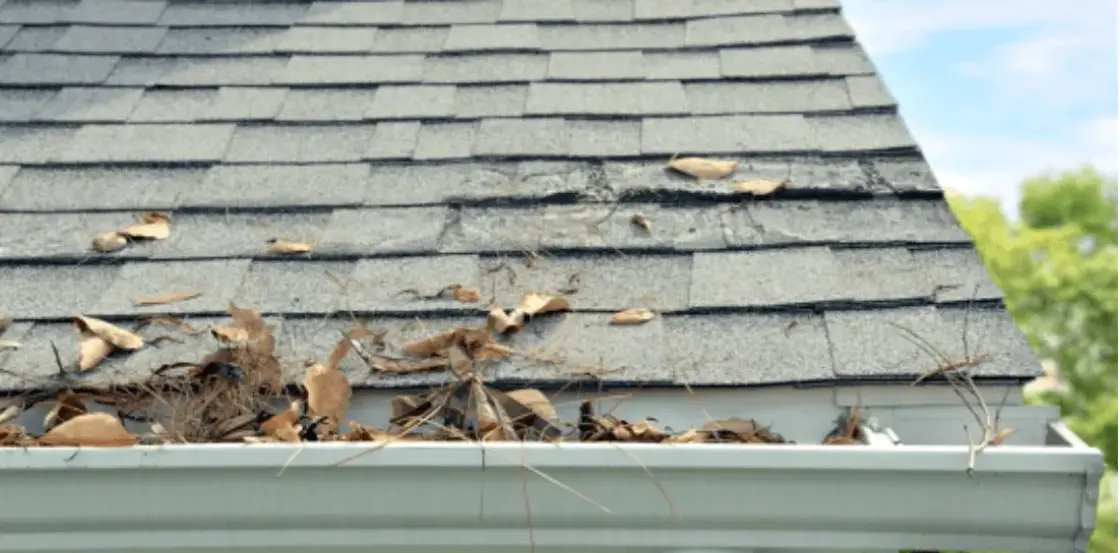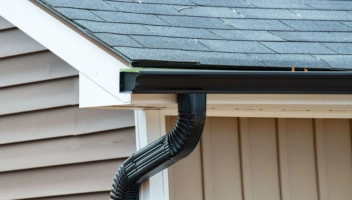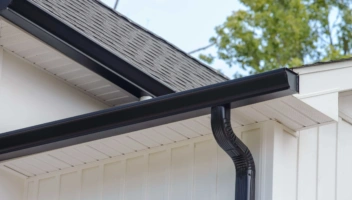How to Clean Out Gutters Safely with a Leaf Blower

Most homeowners dread gutter cleaning, but ignoring the job can cost far more than a Saturday afternoon. Clogged gutters can overflow, soak your siding, and push water into your basement or foundation.
Despite the importance of gutter cleaning, it can feel like a major hassle to be stuck on a ladder for hours every month. That’s why many homeowners wonder: can you make the job faster and safer with tools you already own, like a leaf blower? The answer is yes — but only with the right precautions. A leaf blower can clear out dry leaves and twigs quickly, especially if you use an extension attachment that lets you stay on the ground.
This guide will walk you through the tools you’ll need, step-by-step instructions for cleaning, and the pros and cons of using a leaf blower compared to other methods — plus why prevention is the smartest long-term gutter solution altogether.
In this article
- Why Gutter Cleaning Matters
- Tools and Prep Checklist
- Step-by-Step: Cleaning with a Leaf Blower
- Clearing Out the Downspouts
- Pros and Cons of Using a Leaf Blower
- Comparing Gutter Cleaning Methods
- Prevention is Best
- Frequently Asked Questions
Why Gutter Cleaning Matters
Gutters are designed to direct rainwater safely away from your home. When gutters are blocked, that water backs up. Instead of flowing through downspouts, it pours over the sides. The overflow can saturate soil, erode landscaping, and seep into your foundation.
Clogged gutters may even lead to water stains on ceilings, warped window frames, or peeling paint. Over time, trapped moisture can encourage mold, which is costly to remove and a hazard to your health. Clogs also attract pests like mosquitoes, mice, squirrels, and birds.
The simplest way to stay ahead of problems is to put gutter cleaning on your seasonal checklist. Most homeowners should tackle it twice a year — once in the fall, and again in the spring when storms have passed, but most homeowners don’t bother unless there is a problem. Regular gutter cleanings go a long way toward keeping water flowing freely and stopping clogs before they turn into expensive repairs.
Tools and Prep Checklist for Gutter Cleaning with a Leaf Blower
Using a leaf blower to clean out your gutters is easier when you gather your supplies before you start. Here’s what most homeowners find useful:
- A leaf blower (corded, cordless, or backpack-style) with enough power to push out debris
- A gutter cleaning kit or extension wand so you can reach from the ground (instead of climbing ladders whenever possible)
- Safety gear — goggles, gloves, and a dust mask (at minimum) to protect against mold, dust, and droppings
- A tarp or sheet to cover the ground and catch what comes out of the gutters
- Optional add-ons: a leaf blower gutter attachment for ease of use, a garden hose for rinsing, or a wet/dry vacuum if you run into clogs
Spread the tarp under your work area, and move outdoor furniture or grills if they’re close to the house. It’s also a good idea to keep kids and pets indoors until you’ve finished blowing everything out.
Step-by-Step: Cleaning Out Gutters with a Leaf Blower
Plan to do your gutter cleaning on a dry day, when leaves and twigs aren’t matted down. Start near the downspouts, since that’s where water needs a clear path first. To clean out your gutters with a leaf blower from the ground, follow these steps:
- Put on safety gear. Goggles protect your eyes from flying debris, and gloves keep your hands safe from sharp edges while handling the blower.
- Attach the extension. Most blowers can’t reach gutter height without an add-on. Fit the extension or curved wand so the nozzle can angle into the trough from the ground. If you’ll be climbing a ladder, check that the nozzle is secure before carrying it up.
- Prepare the area. Spread your tarp to catch debris and move outdoor furniture out of the way. As you set up, think about your position: stand directly under the gutter if working from the ground, or maintain three points of contact if you need a ladder.
- Clear near the downspout first. This ensures water can exit even if the rest of the gutter isn’t clean yet. Place the nozzle a few inches into the gutter and blow debris away from the downspout opening.
- Work in small sections. Move along the gutter five to six feet at a time. Short bursts of air are usually more effective than holding the trigger constantly.
- Check your progress. Step back to see if any leaves remain stuck. If you notice clumps, angle the blower differently or switch to hand removal.
- Finish with cleanup. Gather the debris from your tarp and dispose of it in yard waste bags. This last step keeps leaves from blowing right back into your gutters.
Clearing Out the Downspouts
You may or may not be able to clear out the downspout with the leaf blower. If you cannot clear out the downspout with the leaf blower, there may be a tough clog that needs to be dislodged with a high-powered garden hose or perhaps by a professional.
Signs of a blockage include water spilling over the sides during rain, gurgling noises, or little to no flow at the bottom.
- Use the blower first. Place the nozzle at the top and blow down. Sometimes this is enough to dislodge twigs.
- Flush with a garden hose. Insert the hose and run water through. If it backs up quickly, the clog is deeper.
- Try a plumber’s snake or wet/dry vac. These tools can help reach stubborn clogs.
When to Call a Professional
If debris won’t budge or if water leaks at joints, forcing it may cause damage. At that point, a professional cleaner can clear the line without harming the system. Hiring help also gives you a chance to ask about long-term fixes. The cost of professional gutter cleaning (~$300 annually) is 10 to 15 times cheaper than repairing the damage it helps prevent ($3,000-$8,000).
Attention homeowners! 🏡 Did you know that LeafFilter offers FREE estimates for your gutter protection needs? Say goodbye to clogs and hello to peace of mind with LeafFilter!✅ To learn more and get started today, visit https://t.co/6tWbQ0wMvX #ClogFree #FreeEstimate #LeafFilter pic.twitter.com/9JOuBzi7Mp
— LeafFilter Gutter Protection (@LeafFilter) July 18, 2023
Pros and Cons of Using a Leaf Blower
A leaf blower can be one of the fastest ways to clear gutters, which is why so many DIYers give it a try. Still, it isn’t the safest method if a ladder is needed, and it won’t solve more serious clogs on its own. Weighing the pros and cons helps you decide if it’s the right tool for your gutter maintenance.
Pros
- Saves time when dealing with light debris. Dry leaves and twigs blow out quickly compared to hand-scooping.
- Less bending and reaching. Using a leaf blower gutter cleaning attachment can reduce how often you need to use ladders for deep gutter cleaning.
- Affordable if you already own one. For many homeowners, the blower and an extension kit cost less than hiring help.
- Reaches tricky spots. Extensions let you clean out gutters over porches or additions with ease.
- Works well alongside gutter guards. A quick pass over the top of gutter guards with a leaf blower clears the surface so the guards keep working at full strength.
Cons
- Doesn’t handle wet or packed debris. Mud, twigs, and heavy buildup usually require hand tools or a hose.
- Creates a secondary cleanup job. Blowing debris out of gutters leaves a pile on your lawn, driveway, or deck.
- Still involves ladder risk if used without attachments. A gutter cleaning kit or extension wand often lets you stay on the ground. Without one, you’ll need a ladder.
- No fix for compacted downspout clogs. A blower can’t clear blockages deep in the pipe, so water may still back up.
- Temporary relief only. Unless you have gutter guards, gutters will fill up again in a matter of weeks or months, so it’s not a long-term solution.
Think of a blower as a quick fix. It gets the job done when conditions are right, but you’ll need other methods for heavy clogs.
Comparing Gutter Cleaning Methods
Here’s how a blower compares to other common approaches:
| Method | Pros | Cons | Best For |
|---|---|---|---|
| Leaf blower | Quick, easy, less contact with debris | Messy, not effective on wet clogs | Dry leaves, DIYers |
| Garden hose | Flushes debris and checks flow | Muddy, requires a ladder | Spot-cleaning and flushing downspouts |
| Gutter scoop | Inexpensive, thorough | Time-consuming, dirty, ladder required | Heavy clogs and wet debris |
| Wet/Dry Vac | Powerful suction can clear clogs and downspouts | Requires setup, heavy to handle on a ladder | Stubborn clogs, wet or compacted debris |
| Gutter guards | Helps prevent clogs long-term | Higher upfront cost, pro install | Homeowners who want to avoid cleaning altogether |
While blowers and scoops work in the moment, only guards help prevent clogs from forming in the first place.
Prevention Is Best
The reality is that no matter how well you clean, leaves and grit will keep falling into your gutters unless you’re using high-quality gutter guards. Ignoring your gutters doesn’t just mean extra cleaning — it can expose your home to unexpected risks of neglecting gutters, like foundation cracks and pest infestations. Prevention is the smarter long-term investment.
LeafFilter gutter guards block debris like leaves and grit while allowing water to effortlessly flow through. Installed by professionals and backed by a limited lifetime transferable warranty, LeafFilter gutter guards help reduce the need for repeated cleanings and protect your home against costly water damage.
If you’re tired of dragging out a ladder twice a year, give the team at LeafFilter a call today.
Frequently Asked Questions
Is it safer to clean out gutters with a leaf blower?
Yes, DIY cleaning out gutters with a leaf blower can be safer if you use the right setup. The safest way to clean out gutters is to work from the ground with an extension attachment, which keeps you off ladders altogether. If you do climb a ladder, follow safety guidelines: keep three points of contact, avoid leaning too far, and have someone nearby to steady the base. Remember that a leaf blower only works well on dry debris, so choose a clear day for the job.
What’s the best tool to clean out gutters without a ladder?
The best tool depends on the type of debris. A leaf blower with a gutter attachment kit is great for light, dry leaves. For wet clogs or mud buildup, a wet/dry vacuum or hose extension often works better. These gutter cleaning tools let you clear debris from the ground and reduce the risks that come with climbing. If you’re dealing with stubborn blockages, you may still need to flush the line or call a professional.
How often should you clean out gutters?
Most experts recommend cleaning out gutters twice a year: once in late fall after the leaves have dropped, and again in spring after heavy rains. If your home is surrounded by tall trees or pine, you may need to check them more often. Regular cleaning is one of the most effective gutter clog prevention steps you can take, protecting your foundation, roof, and landscaping from water damage.
Can gutter guards really eliminate cleaning?
A high-quality gutter guard solution can greatly reduce seasonal cleanings. Micromesh systems, like LeafFilter, help keep out leaves, twigs, and even shingle grit so your gutters stay clearer. While you may still want to rinse the surface occasionally, installing guards removes the need for regular ladder work and gives you a long-term fix instead of a short-term gutter cleaning method.


